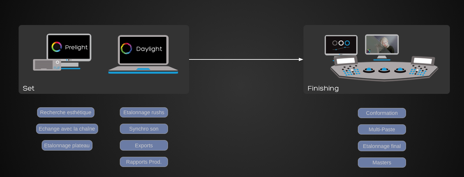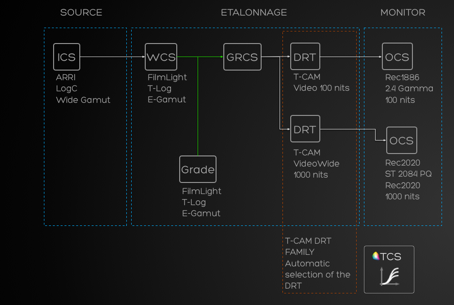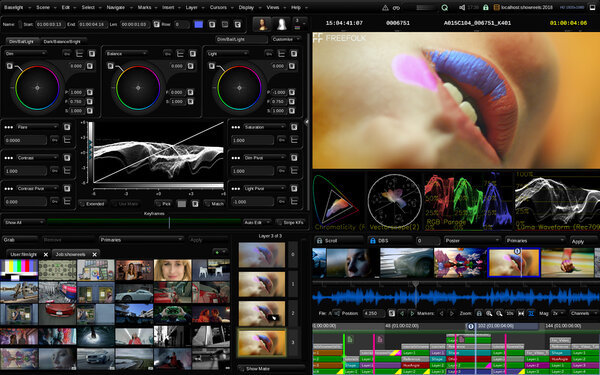Detailled Report of our Visit to FilmLight
By Quentin Bourdin for the AFCFilmLight was originally a manufacturer of film scanners. The Baselight computer program was originally used for treating the scans. It evolved, and is now a high-performance tool for colour timing, managing colorimetric spaces, and image mastering. FilmLight is a corporation with eighty employees of over fifteen different nationalities, with offices in London, Munich, Tokyo, Bombay, Sydney, Mexico City, and Los Angeles. Its clients include the major cinema studios (Netflix, Sony Pictures, Warner Bros, etc.), television channels (BBC, NBC, Sky, France Télévisions, etc.), and production and post-production companies of all sizes (Technicolor Group, Deluxe, Molinar, etc.). In France, the CNC and Color/Digital District, Digital Factory, Films du Soleil, Firm Studio, Le Labo, McMurphy, Medialab, Mikros Image, Motion Partners, NightShift, Onirim, St Louis, Ymagis, and, lately, M141, all work with Baselight.
A number of blockbuster films, major television series, and high-end advertisements were mastered using Baselight. Yvan Lucas is using Baselight to colour time Luc Besson, Quentin Tarantino, and Martin Scorsese’s upcoming films.
The software suite produced by FilmLight includes the following :
- Prelight is used in its paid version by DITs to perform colour timing on set. Originally, Prelight was a piece of hardware called Flip, released in 2010. With the development of more powerful computers, Filmight was able to transform it into a piece of software that runs on Macs. In its free version, it allows cinematographers or their assistants to import images and to treat them using the same tools as those of the colour timer in order to perfect a “look” before shooting. In its free version, it is still possible to export in SDI to check the colour timing on a reference monitor or to use a Tangente console. The software only runs on Macs.
- Daylight is a software used to process and colour time dailies, and to apply the look created by the colour timer or the DIT, to modify it, and to perform all exports needed for production. Daylight allows the user to export a DCP for the screening of the dailies. The software only runs on Macs.
- Baselight is a system for colour timing and for the management of colorimetric spaces. It also allows for the conformation and mastering of the film. The system runs on Linux and the station is assembled by FilmLight.

All Baselight’s tools are available in Prelight and Daylight, except for the Paint and Tracking tools, which are not accessible in Prelight, because of the fact that Prelight only handles still images or camera output. The three software programs communicate with one another thanks to a BLG file that contains the colour timing information and the camera’s metadata. There is one BLG file per shot and each file contains a reference image of the shot and its colour timing. Colour timing information can be saved and modified unlike a LUT, which deletes that information and doesn’t allow it to be reused. It functions like an improved CDL, because it handles multiple levels of colour timing and does not set any limitations on which tools can be used by the DIT or the colour timer. However, the BLG file can only be read by one of the programs in the FilmLight suite. Note that a BLG created in Baselight can be opened and modified for free, using Prelight, and vice-versa. LUTs do not provide for separation between levels, and only allow the user to go from one colour space to another (e.g. Log C to Rec 709), and do not allow for the interaction of the look that it contains and do not allow the user to add masks. Note also that certain old LUTs were only programmed on 8 bits and cause the film to shift to an 8-bit output, which degrades the image. The Look tool was developed to reproduce the colours of old filmstock, which allows you to interact with the effect in order to dose it correctly without harming the image.
Baselight de-bayers RAW files using only the manufacturer-supplied SDK. The software’s de-bayer process is always that supplied by the manufacturer so that the image will always be the same on any station, colour timing software, or VFX software. That is a result of a request placed by the studios three years ago that obliged camera manufacturers to redevelop their SDKs. De-bayering allows for the RAW file to be transformed into a linear signal (as captured by the sensor). The linear signal then sent into the work space (ACES, - FilmLight T-Log Wide Gamut, Wide Color Gamut). Colorimetric modifications are made in that space, during the colour timing phase. Then, a transfer curve (called DRT — Display Rendering Transform) is applied, depending on the equipment used for viewing.

Baselight includes different DRTs that enable the user to adapt colour timing done in a wide work space (ACES, T-Cam, Wide Color Gamut) to other colour spaces (DCI-P3, Rec 709, Rec 2100), whilst keeping the appearance of the colour timing performed intact.
Transfer curves also adapt the signal to the different white points and luminescence levels of the viewing method, especially for HDR. The DRT T-Cam developed by FilmLight is a curve that is intended to be neutral so that all aesthetic decisions on the film’s image are only made during colour timing.


The issue of the difference between RAW and ProRes was also discussed, between an internal de-bayering performed by the camera and an external de-bayering performed by the software. The changes that were observed are a slight loss in latitude and fine details in ProRes. The RAW format left more latitude for colour timing with a better colour quantification and the possibility of correcting the white balance directly using the information from the sensor, before de-bayering.
Three tools are offered for basic colour timing :
- Video Grade (Lift / Gamma / Gain) : the basic tool of software like Resolve. The major pitfall is that Lift and Gamma affect highlights and require the colour timer to correct the gain simultaneously (and vice-versa).
- Film Grade (Contrast / Exposure / Sat) : the tool used for film colour grading, the tool in Baselight allows the modification of pivot points for Shadows / Midtones / Highlights and Contrasts.
- Base Grade (Dark / Balance / Bright) : a tool developed by Baselight that has only existed for a year. It considers the sensor as the base and presents the Waveform with a scale going from -6 to +6 EV. The Balance tool allows the user to increase or decrease the entirety of the signal, where one point is equal to the value of one stop or EV. The settings are distributed in four zones, the Very Low, the Low, the High, and the Very High lights. A tool named FallOff allows the user to soften the transitions between the different zones, which are individually adjustable. The Flare tool allows the user to set a black level at 0, which is a level blacks cannot fall under. Increasing the Flare will make black at 0 grey and decreasing it will cause black at 0 to tend towards an absolute black. That means that reducing the level of dark tones using the Dark tool will allow all dark tones to head towards that 0 black and create what can be compared to the foot of a curve.
Base Grade has also changed its colorimetric motor for image saturation or desaturation. Here, playing with saturation will no longer affect all colour channels in the same way, but will adapt them to the response of the cones in the human eye. Unlike other tools, the saturation offsets are maintained—not amplified—in Base Grade. That results in a more realistic colour saturation that is less prone to derivation.
Baselight shows which tools were used according to a system of layers, allowing for the creation of a Timeline that displays the effects used above each shot. That display shows the tools and effects used on the entire film. It is also possible to cache effects or treatment layers that take up too much computer memory in order to view them in real time.

Some of the tools available in BaseLight :
- Look : Reproduces colour curves of selected types of filmstock and allows the user to modify the aesthetics without touching the DRT (transfer curve). The looks can also be adjusted in intensity to modify the final appearance of the effect. It is also possible to create one’s own Looks.
- BoostContrast : allows the user to increase micro contrast without touching the overall contrast. The different exposure zones are automatically detected so that the user can apply a different contrast setting to each zone.
- BoostShadows : allows the user to set a level of black called flare, and a limit, in order to treat or fill-in dark areas without influencing the selected level of black.
- Texture Equalizer : Thanks to line colour timing, the MFT transfer function allows the user to target particular zones of the image and act on different textures in function of their line density. It can act as a diffusing filter. This makes it possible to smooth out skin tone without losing sharpness. Using it in conjunction with the Paint tool allows the user to restrict the effect to a precise area.
- GridWard : allows the user to modify geometric aberrations created by the lenses. The user can also distort parts of faces or recreate the distortions created by vintage lenses.
- Paint : allows the user to select parts of the image with a paintbrush. It also allows users to cause objects (such as mic booms or cables) to disappear, like Photoshop’s stamp tool.
Thanks to its precise management of colour spaces, Baselight allows users to meet the requirements of demanding broadcasters such as Netflix, which requires a 4K, 16-bit, HDR workflow on its productions. It also allows colour timing to be previewed, thanks to BLG, during the creation of visual effects on the Nuke software. Note that the support contract updates the tools each year and allows the software to be adapted to the needs of each user.
NextShot and Be4Post supply DIT stations that come preloaded with Prelight and Daylight. Digital District, Digital Factory, Mikros, Le Labo, McMurphy, and Mopart own Baselight stations in Paris. A Baselight is also available for training sessions and demonstrations at Be4Post. In France, many colour timers work as freelancers and do not have specific training in a colour timing system. AFDAS training sessions are offered for training in Baselight. In the past, technicians, more than colourists, took the training sessions offered by FilmLight, but such training sessions are still being offered in London. A new partnership with Lapin Bleus Formations has also been created to provide training on all of the software included in the Filmlight suite (Prelight, Daylight, Baselight).

The average time to colour time a film is at least two weeks in France, versus three months for an American blockbuster. It is important for colourists to be as well trained as possible in the available tools before they begin colour timing a film. Gilles Porte, AFC, took Mathilde Delacroix as an example. She is a French colourist who took a three-day training session in BaseLight before she began to colour time The Exchange of Princesses, a film he shot.
The Baselight console has buttons made up of little screens that can be programmed individually by each user in order to save time.

The other example that was cited was that of the film Knife + Heart, with a budget of three million Euros. Colour timing was performed using scans of 35mm and 16mm reversal film exported in DPX 16-bits 4K file format. The colour timer, Jérôme Bréchet, made the conforming copy and the Master at MoPart in Paris. Colour timing was done in Mexico remotely with at least five layers of colour timing per shot.
A half-day session is being organized by Motion Partners in Paris with the same group, to discuss these subjects more in depth, with screenings this time. A report will be published in early October.
The success of this first meeting made it evident that this initiative should be repeated, and another day will be organized by Le Labo Paris in late November 2018. Because places are very limited, please contact paris chez filmlight.ltd.uk if you wish to participate.
The guests on 12 June were Caroline Champetier, Crystel Fournier, Agnès Godard, Stephan Massis, and Gilles Porte, all members of the AFC. François Reumont, Laurent Stehlin, and Quentin Bourdain, of the ENS Louis-Lumière, were also in attendance. The presenters were Jacqui Loran, colour timer and head of customer support for FilmLight.
- Read or reread, in French, the article dedicated to colour timing on BaseLight on Knife + Heart, film by Yann Gonzales, cinematography by Simon Beaufils.
- Read or reread, in French, the interview with cinematographer Simon Beaufils about his work on Yann Gonzales’ film Knife + Heart.
- Read FilmLight’s September French newsletter.
- At IBC 2018 (hall 7, stand B26), FilmLight will be organizing a conference on colour timing and BaseLight. Register to attend the conference.
 En
En Fr
Fr




